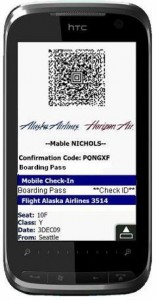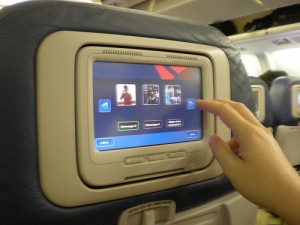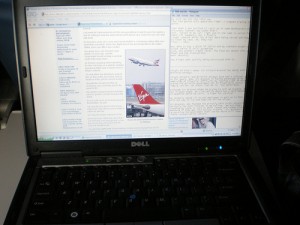
Electronic boarding passes are probably the future of airline travel. Image from Alaska Airlines.
The future is nearing. A little over a year ago I talked about electronic boarding passes becoming a reality. Today, Alaska Airlines and Horizon Air are launching both a mobile-friendly website and electronic boarding passes for passengers flying from Anchorage, Boise, Denver, Las Vegas, Portland, Seattle and Spokane. There are already 30 airports and six airlines testing out this technology: Continental, Delta, Alaska, Horizon and American. Surprisingly, Alaska and Horizon are the first non-legacy airlines to test out the new technology.
Travellers are able to check in using their mobile phone up to 24 hours in advance of their flight. They are given an encrypted barcode along with the passenger and flight information. While going through security, TSA will be able to scan the electronic ticket, check id and the passenger is good to go.
“Alaska Airlines and Horizon Air’s electronic boarding pass and optimized mobile Web site meet the needs of today’s high-tech traveler, ” said Steve Jarvis, Alaska Airlines’ vice president of marketing, sales and customer experience. “Starting today, our customers can expedite the airport check-in process even more and get from curbside to planeside in record time.”
In the next few months, the service will be spread to other Alaska and Horizon cities. In the future, they told me we, “will see more mobile device enhancements to make travel more convenient.”
Is this the future of airline travel? I really think so. No more having to double check to make sure you have your boarding passes. No more having to track down a departure screen to see what your flight status is. The biggest problem will be remember to charge your phone before leaving. Nothing would be more frustrating than waiting in security for 30 minutes, have your phone die, having to go wait in line to get your boarding pass, then get through security again.
Personally, I haven’t been able to test out this new technology. Have any of you been able to? What are your thoughts?
connect | web | twitter | facebook |

Delta Air Lines's in-flight entertainment system. AirlineReporter.com pic.
On a recent flight from Tampa, FL to Seattle, WA, I stopped and observed the other passengers on-board and what they were doing to entertain themselves. On each flight you normally can find the following:
* Sleepers: They don’t want overhead announcements, they don’t want food/drink service, they just want to sleep.
* iPodders: Just sit there listening to their iPod, sometimes with the occasional head-bob to the music.
* Readers: The flight provides a good opportunity to catch up on some reading.
* Talkers: Will talk to someone they know or spend the flight trying to make new friends.
* Laptoppers: Working on projects and now some on the internet.
* Gamers: With their mini-game systems or using their phones to play games.
* Thinkers: People that spend the time staring at their seat back thinking about who knows what.
* Movie Watchers: Will watch any movie being played by the airline.
* Seat back Players: Passengers who will use the airline’s in-flight entertainment to pass time.
* Combos: Tries to do as many of the different activities as possible before the flight ends.
Over the years, there has obviously been a shift. Years back, there would only be the readers, talkers, sleepers, and occasional movie watchers (if it was offered). Now airlines are providing many more options for flyers. From in-flight entertainment, to movies, to now having the internet, there are quite a few options.

It is not easy to fit a laptop on the tray to blog
I often wonder if the millions invested in in-flight entertainment is going to pay off. With so many hand-held gadgets available(iPod, iPhone, laptops, etc) and the addition of Wi-Fi on many airlines now, are flyers still going to be interested in using the airline’s content?
With a device hooked up to the internet, options are almost limitless and on par with entertainment options on the ground. Airlines are able to charge for internet and movies, but so far, power (which will be available on many more planes in the future) and the ability for a passenger to watch something on their own gadget, are free. As the line between phone, mp3 player and computer continues to blur, it seems less likely that passengers would have an interest in paying for limited content on airlines.
I don’t think the concept of in-flight entertainment provided by the airlines will die, but I think it needs to evolve with the times. Is it worth squinting at a small iPhone screen or dealing with a big laptop in front of me to access free entertainment? If airlines would be able to provide more than just TV and movie options (maybe provide the option to interact with other passengers or order food from their seats) could it sway users back to in-flight entertainment? With the addition of Wi-Fi, it would also be beneficial for airlines to integrate the internet into their in-flight systems and charge customers for using it.
However, is it worth it to airlines to pay to keep up with gadgets? In-flight entertainment systems do not come cheap. Airlines, having to foot the initial set-up cost to get airplanes retrofitted with the new technology, still must pay to keep them updated, they pay for additional fuel burn from the weight, and they pay for licensing fees to show certain TV shows and movies. Is it worth it to put that much money into a system, when passengers can provide the technology themselves and airlines can charge for access to the internet, possibly rent movies onboard (either DVD or via network download), and maybe even charge for power usage?

Showing the Alaska RNP read outs. Image from AlaskaAir.com
Alaska Airlines is working on ways to save a few million gallons of fuel per year. The fuel savings will not only trickle down to a passenger’s pocketbook, but it would also cut down on environmental and noise pollutions.
Throughout the summer Alaska has been testing next-generation flight procedures at Seattle-Tacoma International Airport (SEA) that have been dubbed “Greener Skies.”
The new procedure breaks away from the traditional “stair-step” method of descending into an airport. With current protocol, the control tower will assign altitudes airliners will cruise at. The pilot will descend to the new altitude, increase power to maintain the altitude, and wait for the next step. The new process takes advantage of Required Navigation Performance (RNP). With RNP the decent is a smooth, linear, and controlled approach without the need to level off. Alaska says the new system could save 2.1 million gallons of fuel and 22,000 metric tons of carbon emissions per year.
Elliott Pesut, Twitterer for Alaska Airlines, pointed out to me that Alaska is the only major U.S. air carrier with a completely RNP-equipped fleet and fully trained crews. I am sure Alaska won’t be the last. Southwest Airlines recently announced their entire fleet of Boeing 737-700’s have the new technology and are in process of training their flight crews. Alaska is working to gain FAA approval to start using it by next year.
It is great to see an airline taking the leadership role of bringing this technology to the forefront and motivating others to follow suit. I hope that all aircraft at SEA will use the technology and it will spread to all airports and aircraft in the US.

A Boeing 767-300 will employ fuel-saving measures and GPS navigation on a trans-Atlantic flight.
American Airlines Flight 63 from Paris to Miami on Thursday will be the first trans-Atlantic flight to test several fuel-economy measures and GPS navigation.
Strategies to save fuel and reduce carbon emissions, which American and other airlines have been testing individually for awhile now, include one-engine taxi and gradual (as opposed to incremental) take-off and landing.
The Boeing 767-300 will also use GPS technology for a more direct route than typical jetliner highways, again saving fuel and reducing emissions.
And with the Flight 447 tragedy fresh in our minds, it’s important to note that GPS will eventually be able to track planes’ locations far beyond the accuracy of radar.
Source: Los Angeles Times
Photo: Fotos de aviones – Aviocion.Tv

Virgin American's RED where you can order food and drink right at your seat.
In an age where almost everyone has an Debit or Credit Card and that airlines are charging for more things on flights than just movies and alcohol, it seems obvious that airlines should be taking credit cards in flight.
Going cashless has many benefits (not having to have cash on the plane, don’t have to ask for change, encourages people to spend more, etc), but some flight attendants are worried what happens if the card reader doesn’t work? And there are concerns that the credit cards will slow down service.
Although airlines that have already implemented the service show there is a learning curve, but once learned, service can actually pick up.
Virgin America probably has the coolest system where you can order items on the entertainment module in the seat back and actually swipe your credit card there.
Current American cashless airlines:
* United Airlines: Since late April
* AirTran
* American Airlines by June 1
* JetBlue
* AirTran
* Southwest Airlines
* Sun country Airlines
* Frontier Airlines
* Alaska Airlines
* USA3000
* MidWest Airlines
* Virgin America
There could be more — there doesn’t seem to be a full list of airlines and I tried to search down as many as I could.
Although the additional charges might be bothersome, at least most airlines are making an effort to make paying them easier.
Image: NotCot.com





